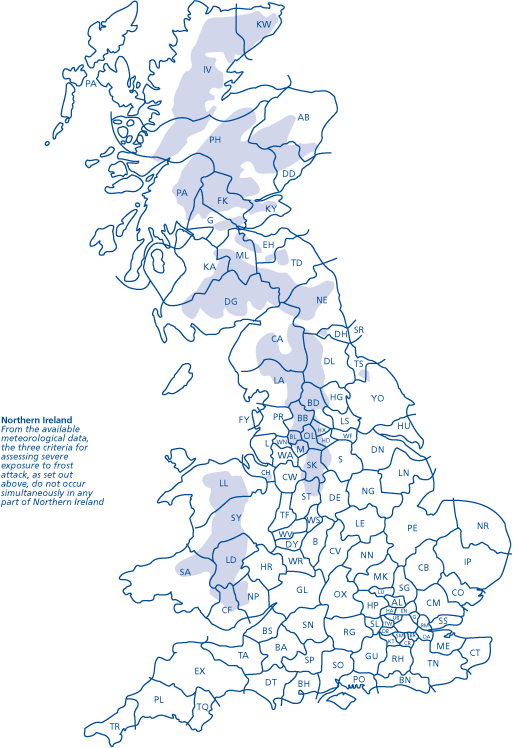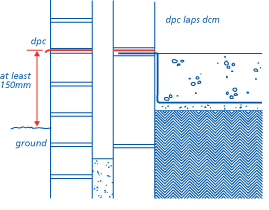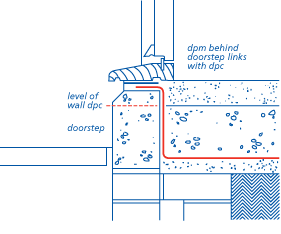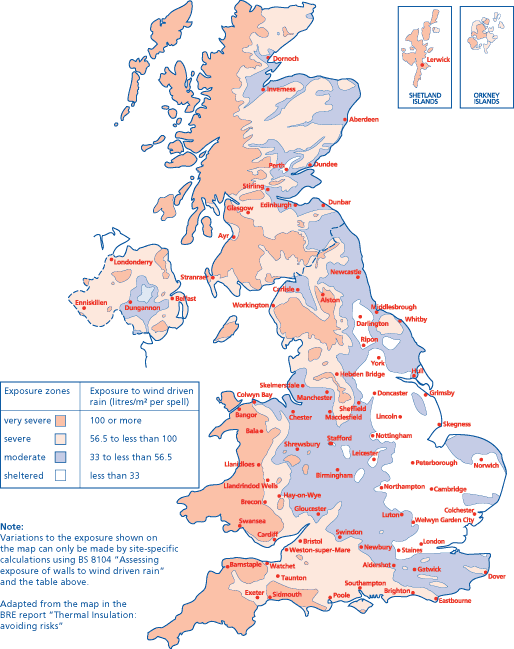6.1 External masonry walls
Appendix 6.1-A
Suitable wall constructions for use with full cavity insulation
| Minimum insulation thickness (mm) |
||||
| Exposure category |
Suitable wall construction | Built-in insulation |
Retro-fill (other than UF foam) |
UF foam |
| Very Severe | Any wall with impervious cladding | 50 | 50 | 50 |
| Fairfaced masonry with impervious cladding to all walls above ground storey | 100 | 100 | N/A | |
| Any wall fully rendered2 | 75 | 75 | N/A | |
| Fairfaced masonry1 | N/A | N/A | N/A | |
| Severe | Any wall with impervious cladding or render2 | 50 | 50 | 50 |
| Fairfaced masonry with impervious cladding or render2 to all walls above ground storey | 50 | 75 | 50 | |
| Fairfaced masonry | 75 | 75 | N/A | |
| Moderate | Any wall with impervious cladding or render | 50 | 50 | 50 |
| Fairfaced masonry with impervious cladding or render to all walls above ground storey | 50 | 50 | 50 | |
| Fairfaced masonry | 50 | 75 | 75 | |
| Sheltered | Any wall with impervious cladding or render | 50 | 50 | 50 |
| Fairfaced masonry with impervious cladding or render to all walls above ground storey | 50 | 50 | 50 | |
| Fairfaced masonry | 50 | 50 | 50 | |
N/A - not applicable
Notes
- In Very Severe exposure locations fairfaced masonry with full cavity insulation is not permitted.
- Render on an external leaf of clay bricks (F2,S1 or F1,S1 designation bricks to BS EN 771) in Severe or Very Severe exposures is not permitted where the cavity is to be fully filled with insulation.
- This table covers walls where the external leaf does not exceed 12m in height.
- The exposure category of the dwelling is determined by its location on the map showing categories of exposure to wind driven rain.
- Fairfaced masonry includes clay, calcium silicate and concrete bricks and blocks and dressed natural stone laid in an appropriate mortar (see Appendix 6.1-C) preferably with struck or weathered or bucket handle joints. Cavity walls of random rubble or random natural stone should not be fully filled.
- Recessed mortar joints should not be used.
- In Scotland, it is not permissible to fill the full width of the cavity with any thermal insulation at the time of construction.
- In Northern Ireland and the Isle of Man it is not permissible to fill the cavity with pumped thermal insulants (for example, UF foam) at the time of construction.
MAP SHOWING CATEGORIES OF EXPOSURE TO WIND DRIVEN RAIN
Appendix 6.1-B
Areas of severe exposure to frost attack
The tinted areas have a frost incidence over 60 days a year, rainfall over 1000mm per year and an elevation over 90m above sea level.
Map reproduced by permission of Hanson.
The following list identifies the postal areas within which the three criteria for severe exposure to frost attack are met.
Only in a few instances is the whole of the post code district within the area of severe frost exposure.
| 54 | ||||||||||||||||||||
| 40 | ||||||||||||||||||||
| 28 | ||||||||||||||||||||
| 27 | ||||||||||||||||||||
| 26 | ||||||||||||||||||||
| 25 | ||||||||||||||||||||
| 24 | ||||||||||||||||||||
| 23 | 23 | |||||||||||||||||||
| 22 | 47 | 22 | ||||||||||||||||||
| 20 | 21 | 84 | 19 | |||||||||||||||||
| 12 | 19 | 48 | 14 | 55 | 20 | 83 | 18 | |||||||||||||
| 11 | 17 | 47 | 13 | 48 | 19 | 82 | 17 | |||||||||||||
| 10 | 16 | 46 | 12 | 47 | 18 | 81 | 16 | 26 | ||||||||||||
| 9 | 13 | 45 | 11 | 46 | 17 | 77 | 15 | 19 | ||||||||||||
| 8 | 12 | 44 | 10 | 45 | 16 | 76 | 14 | 18 | ||||||||||||
| 7 | 24 | 11 | 43 | 8 | 44 | 15 | 75 | 13 | 17 | |||||||||||
| 6 | 23 | 9 | 10 | 42 | 7 | 43 | 14 | 74 | 12 | 16 | ||||||||||
| 5 | 22 | 8 | 9 | 41 | 6 | 28 | 13 | 72 | 7 | 6 | ||||||||||
| 4 | 21 | 7 | 8 | 40 | 4 | 13 | 27 | 12 | 65 | 8 | 7 | 6 | 5 | |||||||
| 3 | 20 | 2 | 7 | 39 | 3 | 12 | 26 | 11 | 64 | 7 | 5 | 6 | 4 | 4 | ||||||
| 5 | 2 | 15 | 1 | 6 | 37 | 9 | 6 | 2 | 11 | 23 | 8 | 63 | 4 | 3 | 4 | 3 | 3 | |||
| 3 | 1 | 13 | 0 | 5 | 8 | 7 | 8 | 4 | 1 | 8 | 8 | 14 | 1 | 62 | 3 | 3 | 2 | 2 | 1 | 1 |
| AA | BB | BD | BL | CA | CF | CH | DD | DE | DG | DH | DL | EH | FK | G | HD | HG | HR | HX | IV | KA |
| 57 | ||||||||||||||||||||
| 55 | 21 | |||||||||||||||||||
| 54 | 20 | |||||||||||||||||||
| 41 | 16 | 19 | 41 | |||||||||||||||||
| 40 | 15 | 18 | 40 | |||||||||||||||||
| 33 | 14 | 41 | 17 | 39 | ||||||||||||||||
| 32 | 13 | 40 | 16 | 38 | ||||||||||||||||
| 28 | 12 | 38 | 15 | 37 | 48 | |||||||||||||||
| 14 | 27 | 11 | 37 | 11 | 36 | 44 | 25 | |||||||||||||
| 13 | 23 | 26 | 12 | 10 | 36 | 10 | 35 | 40 | 24 | |||||||||||
| 12 | 22 | 25 | 11 | 44 | 9 | 35 | 9 | 34 | 39 | 17 | 23 | |||||||||
| 11 | 21 | 8 | 24 | 10 | 8 | 8 | 34 | 8 | 33 | 33 | 16 | 22 | ||||||||
| 10 | 20 | 7 | 23 | 9 | 71 | 7 | 7 | 33 | 7 | 32 | 32 | 15 | 21 | |||||||
| 9 | 12 | 6 | 22 | 8 | 66 | 6 | 6 | 32 | 6 | 31 | 20 | 14 | 20 | 71 | ||||||
| 8 | 10 | 5 | 21 | 7 | 49 | 5 | 5 | 27 | 5 | 30 | 19 | 13 | 19 | 11 | ||||||
| 7 | 9 | 4 | 20 | 6 | 48 | 4 | 4 | 26 | 4 | 26 | 30 | 13 | 12 | 18 | 8 | 22 | ||||
| 6 | 8 | 3 | 16 | 3 | 47 | 3 | 3 | 25 | 3 | 25 | 11 | 11 | 11 | 17 | 5 | 21 | ||||
| 5 | 6 | 2 | 15 | 2 | 46 | 2 | 2 | 24 | 2 | 23 | 10 | 10 | 10 | 13 | 16 | 2 | 18 | |||
| 3 | 13 | 2 | 1 | 11 | 24 | 1 | 19 | 1 | 1 | 23 | 1 | 22 | 6 | 9 | 6 | 10 | 10 | 1 | 9 | 6 |
| KW | KY | LA | LD | LL | M | ML | NE | NP | OL | PA | PH | S | SA | SK | ST | SY | TD | TS | YO | |
| partly within |
| wholly within |
Reproduced by permission of the London Brick Company Ltd.
Appendix 6.1-C
Mortar mixes
Unless recommended otherwise by the brick manufacturer, the mixes in the table below should be used for clay bricks.
In the case of concrete or calcium silicate bricks, particular attention should be paid to manufacturers' recommendations.
Mortar mixes using ordinary Portland or sulfate-resisting cements where required (see also Design clauses 6.1- D5(b) and (d)).
Location |
Recommended cement: lime: sand mix |
Recommended cement: sand mix with air-entraining plasticiser |
Recommended masonry cement: sand mix |
Mortar designation to BS5628-3 |
|
| General wall area above dpc |
in areas of Severe or Very Severe exposure - high durability | 1 : ½ : 4½ | 1 : 3½ | 1 : 3 | (ii) |
| other exposure categories - general use | 1 : 1 : 5½ | 1 : 5½ | 1 : 4½ | (iii) | |
| Below dpc level and in chimney stacks | - high durability | 1 : ½ : 4½ | 1 : 3½ | 1 : 3 | (ii) |
| Cappings, copings and sills | - low permeability | 1 : 0 to ¼ : 3 | - | - | (i) |
Air-entraining plasticiser can be incorporated in the following general use and high durability mortars:
1 : 1 : 5½, cement : lime : sand, or
1 : 1 : 4½, cement : lime : sand.
Retarded mortar
Retarded mortar and most pre-mixed mortars can be used over a longer period of time than site mixed, cement : lime : sand mortars. The timescale of use is defined by the manufacturer, whose advice should be followed:
- protect retarded mortar against freezing prior to use
- do not use retarded mortar beyond the time for which it is effective
- because of delayed setting, temporary bracing of larger walls, for example gable peaks and long walls, may be necessary.
Admixtures and additives
Where air-entraining plasticisers or other additives are to be used, follow manufacturers' instructions:
- do not overdose, 'more is not better'
- an air entraining agent can help reduce frost damage but it is not an anti-freeze
- do not use unauthorised additives.
Appendix 6.1-D
Dpcs and cavity trays
Some positions where dpcs and cavity trays should be provided:
| Location | Provision of dpcs and cavity trays |
| Base of walls, piers, etc | A dpc should be provided a minimum 150mm above adjoining surfaces and linked with the dpm in solid floors. |
| Base of partitions built off oversite where there is no integral dpm | Dpc should be full width of partition. |
| Base of wall built off beam, slab, etc | Detail to prevent entry of damp by driving rain. |
| Parapet | (1) Beneath coping, and |
| In cavity walls over openings, air bricks and the like |
A cavity tray should be provided to direct to the outside any water that enters the cavity. The cavity tray should fully protect the opening. |
| At the horizontal abutment of all roofs over enclosed areas and balconies to walls | A cavity tray should be provided 150mm above the adjoining roof or balcony surface. The tray should be lapped over any roof upstand or flashing to ensure water penetrating into the cavity does not enter the enclosed area. |
| At sloping abutments of all roofs over enclosed areas to cavity walls | A stepped cavity tray should be provided above the roof surface and linked to any roof upstand or flashing to ensure any water penetrating into the cavity does not enter the enclosed area. |
| Doorsteps | A dpc should be provided behind a doorstep where it is higher than a wall dpc. |
| Sills | Where precast concrete or similar sills incorporate joints or are of a permeable material, a dpc should be provided beneath them for the full length and be turned up at the back and the end of the sill. |
| Jambs in cavity | The reveal should be protected throughout its width by a continuous dpc. The width of the dpc should be sufficient to be fixed to, or overlap, the frame and fully protect the reveal. For Severe and Very Severe exposure conditions: rebated reveal construction, with or without closed cavity and dpc. |
Appendix 6.1-E
Durability classification of bricks
BS EN 771-1 classifies clay bricks according to their freeze/thaw resistance and active soluble salts content as follows:
| Durability | Freeze/thaw resistance | Active soluble salts content |
| F2,S2 | Freeze/thaw resistant (F2), durable in all building situations | Low (S2) |
| F2,S1 | Freeze/thaw resistant (F2), durable in all building situations | Normal (S1) |
| F1,S2 | Moderately freeze/thaw resistant (F1), durable except when saturated and subject to repeated freezing and thawing | Low (S2) |
| F1,S1 | Moderately freeze/thaw resistant (F1), durable except when saturated and subject to repeated freezing and thawing | Normal (S1) |
| F0,S2 | Not freeze/thaw resistant (F0), liable to be damaged by freezing and thawing | Low (S2) |
| F0,S1 | Not freeze/thaw resistant (F0), liable to be damaged by freezing and thawing | Normal (S1) |
Calcium silicate and concrete bricks contain no significant active soluble salts. Information on their durability is given in Materials clause 6.1 - M2(b).






















